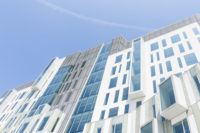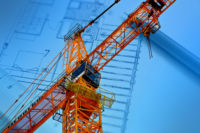At a seasonally adjusted annual rate of $711.6 billion, new construction starts in August slipped 2% from July, according to Dodge Data & Analytics. The decline followed July’s 6% increase, yet kept total construction activity 5% above the relatively subdued pace reported during the second quarter.
The nonbuilding construction sector in August dropped 24% after soaring 26% in July, reflecting decreased activity for public works and power plants, even with the August start of a $1.3-billion natural gas-fired power plant in California. Residential building in August eased back 1%, due to weaker activity for multifamily housing.
Nonresidential building was the growth sector in August, climbing 14% with the start of two massive projects in New York City—the $1.6-billion Moynihan Station and the $1.2-billion Javits Convention Center expansion.
For the first eight months of 2017, total construction starts on an unadjusted basis were $481.7 billion, down 1% from the same period a year ago. The year-to-date performance for total construction was restrained by a 39% drop for the electric utility and gas plant category. If that category is excluded, total construction starts in this year’s first eight months would be up 2% from the same period in 2016.
The August data produced a reading of 151 for the Dodge Index (2000=100), compared to the 154 reported in July. The Dodge Index began 2017 on a heathy note, averaging 160 in the first quarter, but then fell 11% to 143 in the second quarter.
The readings for the Dodge Index in July and August suggest that total construction starts are on track for a partial rebound in the third quarter, although September will reflect some negative impact from Hurricanes Harvey and Irma.
“What stands out about the August statistics is the strength shown by the institutional side of nonresidential building, which is consistent with a broader trend that’s taken hold during 2017,” said Robert A. Murray, chief economist for Dodge Data & Analytics.
“The institutional building segment (which includes such project types as transportation terminals, convention centers and educational facilities) is providing much of the lift this year to nonresidential building, while the commercial building segment has decelerated after a 20% surge in 2016,” Murray said.
“It’s believed that total construction starts for the U.S. should be able to register growth for 2017 as a whole, helped by this year’s strength for institutional building, notwithstanding the near-term disruption to construction activity caused by Hurricane Harvey in the Houston area and Hurricane Irma in Florida.”
Nonresidential Building
Nonresidential building in August was $268.3 billion (annual rate), a 14% gain that followed a 5% decline in July. The institutional building categories as a group soared 27%, led by a 174% hike by the transportation terminal category.
Most of the upward push came from the $1.25-billion rail terminal segment of the $1.6-billion Moynihan Station project in New York City, which also includes $300 million for office space and $50 million for retail space.
This project involves redevelopment of the James A. Farley Post Office Building into a new train hall, with additional office and retail space, expanding the existing Penn Station in Manhattan.
Other transportation terminal projects in August included the $229-million Federal Inspection Services facility at San Diego International Airport and $90 million for airport security infrastructure at San Francisco International Airport.
The amusement and recreational category also climbed sharply in August, advancing 144%, with the lift coming from the $1.2-billion expansion to the Jacob K. Javits Convention Center in New York City.
In addition, the educational facilities category increased 39% in August, following lackluster activity during the previous three months. Large educational facilities projects that reached groundbreaking in August included a $200-million biology research building at Yale University in New Haven, Conn., and the $153-million Medicine and Heart Health Institute building at the University of South Florida in Tampa.
Five K-12 school buildings valued at $50 million or more were entered as August starts, located in Brooklyn, N.Y. ($93 million and $74 million), Columbia City, Ind. ($65 million), the Bronx, N.Y. ($51 million), and Dallas ($50 million). On the negative side, health care facilities dropped 41% in August after jumping 117% in July, which featured the start of the $1.5-billion Penn Medicine Patient Pavilion in Philadelphia.
August declines were also reported for public buildings (courthouses and detention facilities), down 12%; and religious buildings, down 22%.
The commercial categories as a group increased 11% in August, bouncing back after a 20% decline in July. The office building category registered a 38% gain in August, aided by the start of these large projects: a $523-million office campus in Redwood City, Calif.; the $322-million Moffett Towers II office park in Sunnyvale, Calif.; the $300-million office portion of the Moynihan Station project in New York City; and the $145-million NCR headquarters second office building in Atlanta.
Hotel construction in August was also up sharply, rising 78% after a weak July with the help of these projects: the $342-million hotel portion of the $500-million Resorts World Hotel and Casino (phase 1) in Las Vegas; the $224-million Oregon Convention Center Hotel in Portland; the $200-million Seminole Hard Rock Tampa hotel tower in Tampa, Fla.; and the $141-million hotel portion of the $226-million Sycuan Hotel and Casino expansion (phase 1) in El Cajon, Calif.
Commercial garage construction improved 6% in August, but declines were reported for warehouses, down 12%; and stores, down 37%.
Even with its August decline, the warehouse category included groundbreaking for a $110-million Dollar Tree distribution center in Warrensburg, Mo., and a $92-million Amazon fulfillment center in Salt Lake City.
The manufacturing plant category in August plunged 41% after a relatively strong July, with the largest August project being a $225-million health care diagnostics production facility expansion in East Walpole, Mass.
Residential Building
Residential building, at $293.4 billion (annual rate), settled back 1% in August. Multifamily housing retreated 12% following its 34% July increase, resuming the moderate downward trend that’s taken hold in 2017 after elevated activity during 2016.
Six multifamily projects valued at $100 million or more reached groundbreaking in August, compared to nine such projects in July. The large multifamily projects in August were led by five projects in the New York City area, with two in Brooklyn ($261 million and $175 million), two in Manhattan ($225 million and $150 million), and one in Sayreville, N.J. ($137 million).
In August, the top five metropolitan areas ranked by the dollar volume of multifamily starts were: New York City, Boston, Atlanta, San Francisco and Dallas-Ft. Worth.
Through the first eight months of 2017, New York City was still the leading market in terms of the dollar amount of multifamily starts, despite retreating 14% from the same period of 2016.
Rounding out the top five multifamily markets during the first eight months of 2017, with their percent change from a year ago, were: Los Angeles, down 8%; Chicago, down 26%; San Francisco, up 7%; and Atlanta, up 45%.
Single-family housing in August rose 4%, showing modest improvement after losing some momentum during the previous four months. By major region, single family housing performed as follows in August: the West, up 9%; the Midwest, up 6%; the South Atlantic, up 3%; the South Central, up 2%; and the Northeast, unchanged from July.
Nonbuilding Construction
Nonbuilding construction in August was $149.8 billion (annual rate), down 24%. The previous month had jumped 26%, reflecting a 64% surge by the electric utility and gas plant category, which included the July start of two massive gas-fired power plants, located in California ($2.2 billion) and New York ($1.6 billion).
The public works segment of nonbuilding construction, up 11% in July, had been lifted by the start of such projects as the $1.5-billion Brownsville to Nueces natural gas pipeline in Texas and the $844-million Vista Ridge water supply pipeline project in San Antonio.
In August, the electric utility and gas plant category fell 58%, returning to a level similar to what was reported during the first six months of 2017.
While August included the start of the $1.3-billion AES Alamitos Energy Modernization of a natural gas-fired powerplant in Long Beach, Calif., the next-largest powerplant project was the $350-million Santa Rita Wind Farm in Big Lake, Texas.
The public works categories as a group dropped 5% in August, with weaker activity for river and harbor development, down 35%; miscellaneous public works (including pipelines), down 39%; and water supply construction, down 56%. Running counter was a 78% increase for sewer construction, which included a $178-million biosolids treatment facility in Dallas and a $177-million waste water treatment plant in Queens, N.Y., as August starts.
Also showing growth in August was highway and bridge construction, which advanced 23% as the result of such large projects as a $475-million bridge replacement in Birmingham, Ala., and a $460-million high-occupancy toll lanes project in Alexandria, Va.
Through the first eight months of 2017, the top five states in terms of the dollar amount of highway and bridge construction starts were: Texas, California, Florida, Pennsylvania and New York. Virginia ranked number 10 in the first eight months of 2017, while Alabama ranked number 12.
The 1% decline for total construction starts on an unadjusted basis during the first eight months of 2017 was the result of decreased activity for nonbuilding construction, as both nonresidential building and residential building posted gains. Nonbuilding construction fell 12% year-to-date, with electric utilities and gas plants down 39% and public works down 2%.
Nonresidential building year-to-date climbed 5%, with its institutional building segment up 14% while commercial building slipped 2% and manufacturing building dropped 4%.
Residential building year-to-date was up 1%, as an 8% increase for single-family housing slightly outweighed a 15% slide for multifamily housing.
By major region, total construction starts during the January-August period of 2017 revealed this behavior compared to a year ago: the Northeast, up 9%; the South Atlantic, up 5%; the West, up 3%; the South Central, down 8%; and the Midwest, down 14%.



